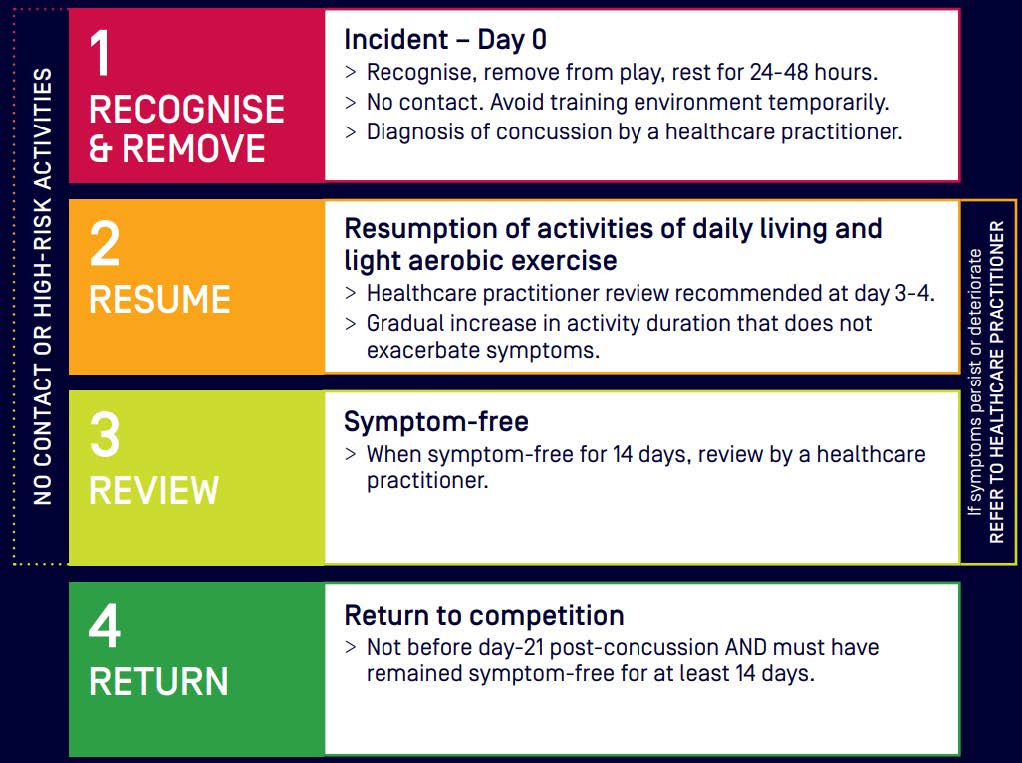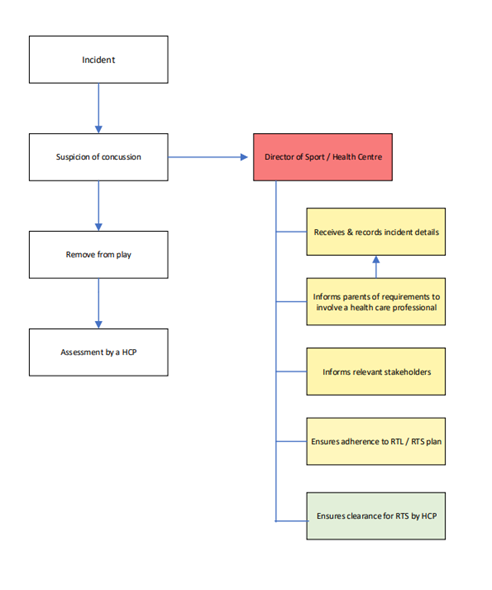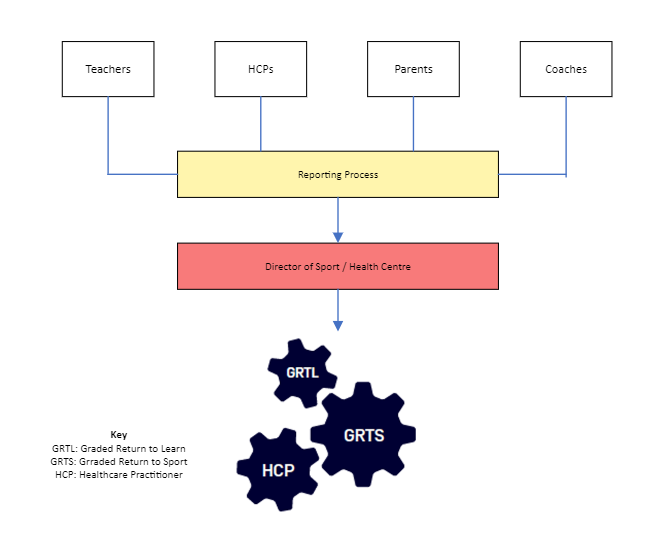Concussion
A boy who has received a diagnosis of concussion from a medical practitioner, will be required to follow the guidelines for a gradual return to learning, sport and play.
Return to learning, sport and play
Due to students developing brains current evidence supports a gradual return to school/learning and play
Your son should have a period of complete physical and mental rest (‘brain rest’). He should refrain from sport, vigorous play and activities that require mental concentration including school/learning, computer and phone use, television and gaming consoles for 48 hours. Once your son has been symptom free for 48 hours he can commence a gradual return to school, play and sporting activities as shown below.
CCGS Graded Return To Sport Framework (GRTSF)
The risk of complications from concussion is increased if a player is permitted to return to sport before they have fully recovered. It is important that athletes do not return to contact activities or competition, until they have fully recovered. The graded return to sport framework (GRTSF) for community and youth assists athletes/ coach/parents/teachers with concussion management through the recovery process and time frames for a safe return to sport/learn.
The AIS return to sport protocol for community and youth sport includes;
- Introduction of light exercise after an initial 24-48 hours of relative rest.
- Several checkpoints to be cleared prior to progression.
- Gradual reintroduction of learning and work activities. As with physical activity, cognitive stimulation such as using screens, reading, undertaking learning activities should be gradually introduced after 48 hours or as recommended by a concussion specialist.
- At least 14 days symptom free (at rest) before return to contact/collision training. The temporary exacerbation of mild symptoms with exercise is acceptable, as long as the symptoms quickly resolve at the completion of exercise, and as long as the exercise-related symptoms have completely resolved before resumption of contact training.
- A minimum period of 21 days until the resumption of competitive contact/collision sport.
- Return to learning activities should take priority over return to sport. That is, while graduated return to learning/activities and sport activities can occur simultaneously, the athlete should not return to full contact sport activities until they have successfully completed a fully return to learning activities.
After the initial period of relative rest a graded return to school is advised.
Recent studies encourage initiation of low-intensity exercise 24-48 hours post-concussion irrespective of the presence of low-level symptoms. Mild and brief exacerbation of symptoms may occur during progression through the GRTSF. If there is moderate or severe exacerbation of symptoms or symptoms persist until the next scheduled bout of activity (considered prolonged symptoms) then a review with a concussion specialist is recommended.
The GRTSF requires those under 19 years of age to be symptom free for 14 days (at rest) before return to contact training, and not return to competitive contact sport until a minimum of 21 days from the time of concussion. To be clear, that is not 14 days from the time of concussion. It is 14 days from when the athlete becomes symptom-free. The day of the concussive incident is deemed day O of the GRTSF.
Any student who has received a diagnosis of concussion from a sport related activity will be registered on the school’s concussion register in the Senior School by the Director of Sport and in the Preparatory School by the Sportsmaster. (Other concussions will be added to the register by the Health Centre on confirmation of a diagnosis)
FRIDAY MATCH – PLAYER shows Signs and Symptoms of Concussion
- Day of concussive incident is considered ‘Day 0’
- The 14 day symptom free period does not start until the first day that the athlete is symptom free
Key:
| Incident |
| Symptomatic |
| Symptom-free |
| Contact training |
| Full competition |
| Athlete symptom-free on day 3 (Monday of the 1st week) | ||||
| Friday | 5. Friday Fixture | 12. Friday Fixture | Play Friday Fixture | Friday |
| Saturday | 6. Saturday | 13. Saturday | Saturday | Saturday |
| Sunday | 7. Sunday | 14. Sunday | Sunday | Sunday |
| 1. Monday | 8. Monday | Monday | Monday | Monday |
| 2. Tuesday | 9. Tuesday | Tuesday | Tuesday | Tuesday |
| 3. Wednesday | 10. Wednesday | Wednesday | Wednesday | Wednesday |
| 4. Thursday | 11. Thursday | Thursday | Thursday | Thursday |
| Athlete symptom-free on day 7 (Friday of the 2nd week) | ||||
| Friday | 1. Friday Fixture | 8. Friday Fixture | Friday Fixture | Play Friday Fixture |
| Saturday | 2. Saturday | 9. Saturday | Saturday | Saturday |
| Sunday | 3. Sunday | 10. Sunday | Sunday | Sunday |
| Monday | 4. Monday | 11. Monday | Monday | Monday |
| Tuesday | 5. Tuesday | 12. Tuesday | Tuesday | Tuesday |
| Wednesday | 6. Wednesday | 13. Wednesday | Wednesday | Wednesday |
| Thursday | 7. Thursday | 14. Thursday | Thursday | Thursday |
SATURDAY MATCH – PLAYER shows Signs and Symptoms of Concussion
- Day of concussive incident is considered ‘Day 0’
- The 14 day symptom free period does not start until the first day that the athlete is symptom free
Key:
| Incident |
| Symptomatic |
| Symptom-free |
| Contact training |
| Full competition |
| Athlete symptom-free on day 3 (Tuesday of the 1st week) | ||||
| Saturday | 5. Saturday Fixture | 12. Saturday Fixture | Play Saturday Fixture | Saturday |
| Sunday | 6. Sunday | 13. Sunday | Sunday | Sunday |
| Monday | 7. Monday | 14. Monday | Monday | Monday |
| 1. Tuesday | 8. Tuesday | Tuesday | Tuesday | Tuesday |
| 2. Wednesday | 9. Wednesday | Wednesday | Wednesday | Wednesday |
| 3. Thursday | 10. Thursday | Thursday | Thursday | Thursday |
| 4. Friday | 11. Friday | Friday | Friday | Friday |
| Athlete symptom-free on day 7 (Saturday of the 2nd week) | ||||
| Saturday | 1. Saturday Fixture | 8. Saturday Fixture | Saturday Fixture | Play Saturday Fixture |
| Sunday | 2. Sunday | 9. Sunday | Sunday | Sunday |
| Monday | 3. Monday | 10. Monday | Monday | Monday |
| Tuesday | 4. Tuesday | 11. Tuesday | Tuesday | Tuesday |
| Wednesday | 5. Wednesday | 12. Wednesday | Wednesday | Wednesday |
| Thursday | 6. Thursday | 13. Thursday | Thursday | Thursday |
| Friday | 7. Friday | 14. Friday | Friday | Friday |
THURSDAY MATCH – PLAYER shows Signs and Symptoms of Concussion
- Day of concussive incident is considered ‘Day 0’
- The 14 day symptom free period does not start until the first day that the athlete is symptom free
Key:
| Incident |
| Symptomatic |
| Symptom-free |
| Contact training |
| Full competition |
| Athlete symptom-free on day 3 (Sunday of the 1st week) | ||||
| Thursday | 5. Thursday Fixture | 12. Thursday Fixture | Play Thursday Fixture | Thursday |
| Friday | 6. Friday | 13. Friday | Friday | Friday |
| Saturday | 7. Saturday | 14. Saturday | Saturday | Saturday |
| 1. Sunday | 8. Sunday | Sunday | Sunday | Sunday |
| 2. Monday | 9. Monday | Monday | Monday | Monday |
| 3. Tuesday | 10. Tuesday | Tuesday | Tuesday | Tuesday |
| 4. Wednesday | 11. Wednesday | Wednesday | Wednesday | Wednesday |
| Athlete symptom-free on day 7 (Thursday of the 2nd week) | ||||
| Thursday | 1. Thursday Fixture | 8. Thursday Fixture | Thursday Fixture | Play Thursday Fixture |
| Friday | 2. Friday | 9. Friday | Friday | Friday |
| Saturday | 3. Saturday | 10. Saturday | Saturday | Saturday |
| Sunday | 4. Sunday | 11. Sunday | Sunday | Sunday |
| Monday | 5. Monday | 12. Monday | Monday | Monday |
| Tuesday | 6. Tuesday | 13. Tuesday | Tuesday | Tuesday |
| Wednesday | 7. Wednesday | 14. Wednesday | Wednesday | Wednesday |
Protocol for those with multiple suspected concussions
An athlete with a history of multiple concussions is at risk of experiencing prolonged symptoms. Those who suffer from multiple concussions within a short period of time should be managed more conservatively and be assessed by a clinical management team with specific training and expertise in concussion. Multiple concussions can be a minimum of two concussions within a 3-month period, or a minimum of three concussions in a 12-month period. If this occurs, the individual should follow a more conservative return to sport protocol. There is no evidence regarding specific time frames for return to sport following multiple concussions. The timeframes will be influenced by factors such as the severity of the most recent injury, the number of previous concussions and the general medical history of the athlete. A recommended starting point for return to sport after second concussion within three months, would be 28 days symptom-free before return to contact training and a minimum of six weeks from the time of the most recent concussion until return to competitive contact.
Any student who has received a diagnosis of concussion from any other activity besides sport will be registered on the school’s concussion register by the Health Centre. A student who receives two concussions in a 3-month period or a minimum of three concussions in an 12-month period must see a concussion management specialist and follow their individual management plan before he can return to playing PSA sport with a CCGS team.
Appendix A: Systems for managing the concussed student in the school environment
Appendix B: Systems for managing the concussed student in the school environment
Christ Church Grammar School has referenced the AIS Australian Concussion Guidelines for Youth and Community Sport, February 2024.



